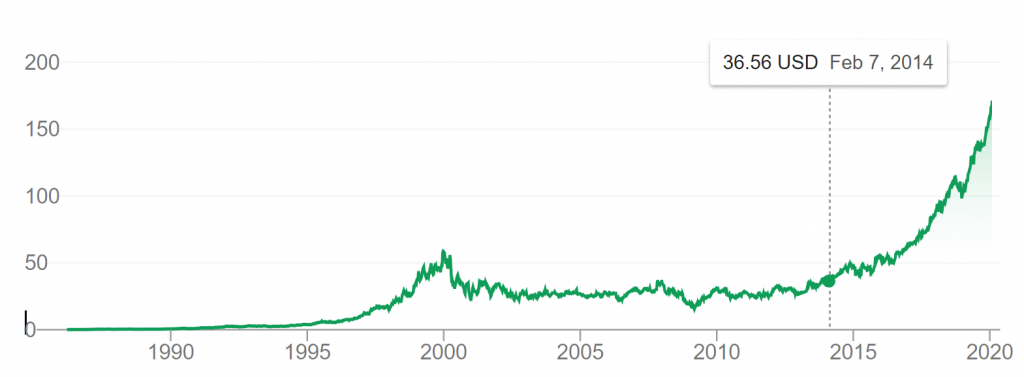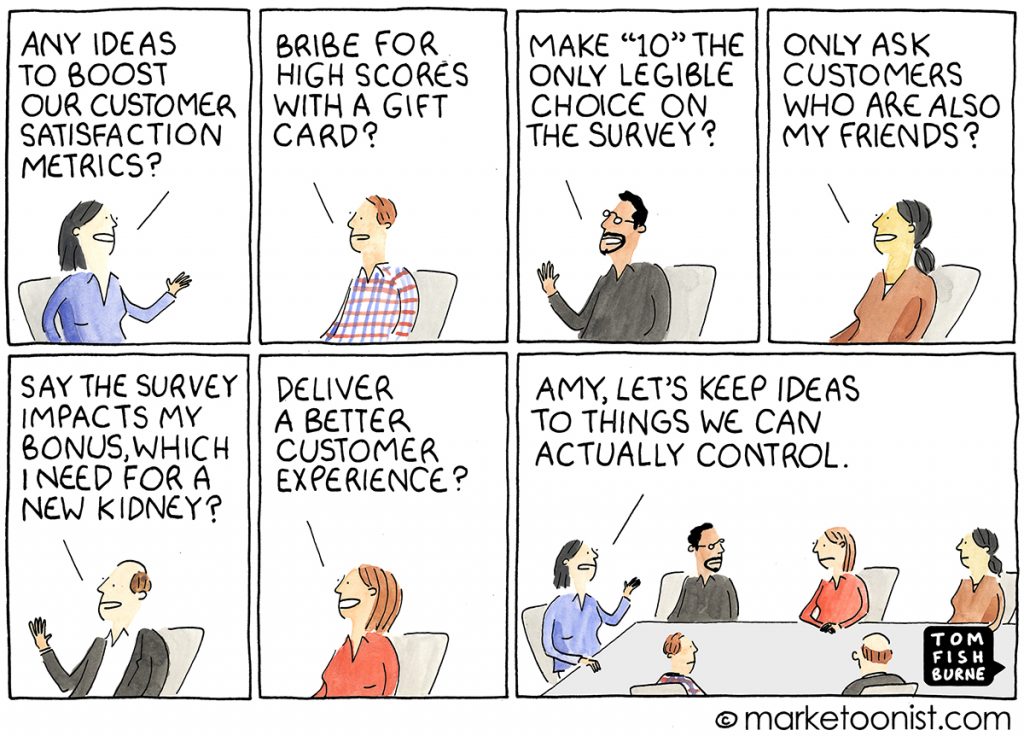
We are fortunate to live in time when customers can share feedback instantaneously via Twitter, Facebook page post or message, live chat with an agent or a phone call. How business reacts to the feedback determines growth trajectory, brand reputation, ability to attract and retain top industry talent and a few more important things. Successful companies thrive because they take feedback to heart and act on it quickly. How do these brands make you feel – Amazon, Netflix, TraderJoe, Apple, Southwest Airlines? Some business are punished because they do not listen to their customers. Do you experience the same emotions thinking about these brands – Comcast, Wells Fargo, Spirit Airlines, United Airlines? My guess – you don’t.
In this article we break down Jeff Bezos’es “customer obsession” into concrete steps your business can take to get ahead in the game. We will analyze a few companies that went through customer experience transformation and became stronger.
It is worth noting, that this article is not about a colossal leadership failure that resulted in out-pour of bad publicity. There have been a few of them recently that wiped billions from companies valuations overnight:
- Boeing 737 Max – business focused on cost cutting to increase profit margins, combined with cultural decay and disconnect between top management and front line production engineers.
- Equifax breach – failure of internal oversight, combined with poor leadership decision to delay public disclosure. To make matters worse, company forced customers to sign-away class-action lawsuit rights in order to find out if they were affected by breach.
- United Airlines – company focused on the bottom line, lack of customer-focused culture and poor judgement call of flight crew wiped a $1 billion from valuation.
In all fairness, companies that suffer bad PR can be a great investment if they weather the storm. With higher risk comes higher reward. As an investor, you may want to look at company fundamentals during PR debacle and consider buying it at a discounted price, when the rest of the market runs for the hills. Having said that, this topic is outside of the scope of this article and may be covered in the future.
Why are we here?
It takes 20 years to build a reputation and five minutes to ruin it. If you think about that, you’ll do things differently.
Warren Buffett
In January 2020, ScholarShare rolled-out a new and improved investment management system to all users. They were up-beat about this system in all prior communications and didn’t dive into specifics. The moment system went live, a segment of their customers were negatively affected. Customer who used Quicken lost ability to download transactions from ScholarShare. When this issue was brought to their attention, response fell short of people’s expectations.
In an effort to enhance the overall customer experience and online capabilities of the ScholarShare 529 college savings program, a change in recordkeeping platforms was made on January 27. While nearly all program services were maintained or improved, one service has been impacted. Specifically, for those account owners who currently utilize the Quicken download function, this service will no longer be supported. The ScholarShare 529 team will continue to seek solutions that assist account owners working toward their college savings goals, and will share any advances as they are implemented. We sincerely apologize for any inconvenience.
ScholarShare529
Let’s look at this situation and see what went wrong that resulted in customer dissatisfaction.
- ScholarShare was a great financial instrument, but one incident has sent some customers looking for alternatives. 33% of Americans say they’ll consider switching companies after just a single instance of poor service (according to American Express study of 2017).
- ScholarShare failed to identify customers who might be impacted by their changes prior to system roll-out and failed to notify them in advance.
- ScholarShare did not leave an option for affected customers to stay on the old platform until issue was resolved, nor did they delay roll-out of the new system until issue was addressed. U.S. companies lose more than $62 billion annually due to poor customer service (according to New Voice Media).
- ScholarShare response did not provide a path forward for customers to continue using Quicken. Quicken is designed to centralize management of financial aspects and lack of integration with ScholarShare meant fragmentation of that experience. 74% of people are likely to switch brands if they find the purchasing process too difficult (according to Salesforce research).
Customer Experience
There are few ways to measure customer experience and there’s a great blog post about it on Retently. In summary:
- Net Promoter Score (NPS) is designed to answer how liked your current customers are to recommend your product or brand to others.
- Customer Satisfaction Score (CSAT) will help you measure how customers felt while doing business with you.
- Customer Effort Score (CES) tracks amount of effort your customers had to put in to purchase a product or receive a service.
No one is more important than the other. When combined, they draw a good picture of what your customers are going through.
Amazon was founded around improvement of customer experience. It wasn’t founded as a technology company, but rather as a company that improves peoples’ lives.
According to Forrester research, 66% of adults feel that valuing their time is the most important thing a company can do to provide them with good online customer experience. So by induction, Amazon catered directly to this audience. Amazon reduced end-to-end time between someone thinking they need a product and having one in their hand. They focused on entire experience.
There is a great book that speaks to the same principles – Outcomes over Output by Josh Seiden. In the book, Josh explains how focusing on a change in customer behavior has direct impact on business results. It is also a shorter path than focusing on technology.
Microsoft has started growing substantially since Satya Nadella was appointed a CEO on February 4th, 2014. In his book, Hit Refresh, Satya talks about a need to step back and re-evaluate your priorities and approach. Even though Microsoft is a technology company, it’s mission has nothing to do with it – “Empower every person and organization on the planet to achieve more“. Satya instituted growth mindset and customer obsession from top executives down to front-line managers.

An example of focus on customer success is that anyone can tweet at Scott Guthrie at any time with their issue and he will rally the troops if needed. Business owners and engineers tweet at him all the time when they are having issues with Azure. He chose to make himself available for customers, which helped propel Azure into a solid 2nd place in cloud computing business. An icing on the cake is $10 billion US Department of Defense contract that Microsoft wan over Amazon.
Practical Customer Obsession
Lots of businesses have trained personnel to interact with customers – be it sales or support or anything in between. However, few get it right. It is not enough to just have people on payroll in the right departments, but it is what those people do to serve the customers. If a business could serve customers without writing a single line of code – it happily would. It is easy to get caught in day-to-day activities and forget why business exists in the first place.
Culture
Customer obsession starts at the top of the company. Senior leadership must believe, deep in their hearts, that they are appointed to serve the customers, not themselves or shareholders. They will ultimately serve themselves and shareholders if they serve customers first
Changing company culture is a complicated process and is beyond the scope of this article. Some people will embrace the change and will evangelize it, however, some will not. Focus on serving the customer must percolate through entire leadership chain down to engineers on the ground. Every link in this chain needs to be believe that they are called upon to serve the customer.
Incentive scheme
Change will not happen if the right behaviors are not rewarded, while wrong behaviors are reprimanded. Just like humans are trained not to jump from the tree because they risk hurting themselves, they need to be trained to recognize right moves from the wrong ones.
To drive customer focus change, embed CSAT evaluation into every engineer and manager performance review. Departments with higher CSAT needs to become public examples and be rewarded. Their success should be analyzed and shared with everyone at the company. People, who seek social status will be motivated by this move and it will create a virtuous cycle.
Measure
Humans are designed to beat any metric you put in front of them, sometimes in creative ways.
For incentive scheme to work there needs to be a correlation between metrics measured and company books. Great customer service has a proven ROI – 5% increase in customer retention increases profits from 25% to 95% (according to Bain). Also is it between 5 and 25 times more expensive to acquire new customer than retain existing ones (according to Harvard Business Review). So if you see CSAT going up yet your balance sheet quarter after quarter is flat – look into what’s being measured.
You will have to create a process with short cycle to gauge your progress. “Quarterly customer issue” review will not cut it is you won’t have enough time to react. Think “Daily customer issues”. Scope doesn’t have to be company wide – it will be a time sink for everyone. However, if each scrum team has a daily customer issue pulse for 30 minutes, it will be a good start.
Demonstrate that you and your leadership cares. Going back to the first point about culture – it is not possible to instill a culture change if leadership doesn’t live it every day. If you or your boss wants to change culture – he or she must show up in every meeting dedicated to it, in person.
Know Your Customers
As creepy as it sounds – you need to know enough about your customers to make right decisions. Build a strong telemetry pipeline that gives you insights into product usage by your customers. If you know who the second cousin of younger sister of your customer’s nephew is – you’ve gone too far.
Focus on things relevant to your business, but not more. Customers are sensitive about their data so keep your collection contained. You want to know which customers are using what capabilities of your products at what points in time. This will allow you to assess potential impact on your customers of any changes you plan to do in the future. For example, going back to our ScholarShare case – if they knew which customers used Quicken before they rolled out new system, they could have communicated a breaking change to them. Or even better – let them stay on the old system. Don’t be ScholarShare.
There’s hardly anything more annoying in customer support than data collection and case creation at the beginning of the call. “Hello XYZ, please share your first name, last name, phone number and email address to reach back to you if we get disconnected“. Have you ever been greeted with this message? Back to Forreseter research – time is of the essence for adults. Don’t waste it. When customer calls – make sure you know who he or she is and don’t ask questions.
Some of the best customer support is provided by Apple and American Express. You can get a live human on the other end of the line with a single button click bypassing self-service bots. 75% of customers believe it takes too long to reach a live agent (according to Harris Interactive). In most cases you end-up talking only to a single human without transfers and that human solves your problem. There are cases, when they predict the reason for your call and give you an answer before you get to state your case 🤯.
Deliver
When people in the organization believe in their mission, this part will come naturally. You should expect following behaviors to manifest more frequently:
- Lines between Sales, Engineering and Support will get blurry. People will collaborate more tightly and frequently. Sales will engage engineering to help land the contract. Engineering will sit side-by-side with support to learn and train them. Customers will have direct line to engineering bypassing support. If this isn’t happening – forcefully bring cross-discipline people together and make them talk to each other.
- Sense of urgency. People will not think it would be acceptable to wait until the next business day to solve a customer issue that impacts customer today. This will also come naturally because engineering will be engaged with customers directly and get a sense of urgency from them.
- Specific customer scenarios will drive product design. Gone will be the days when people lock themselves in the room for a few days of offsite and emerge with a brilliant new product idea all by themselves. Everything business plans to deliver will have direct ties to specific customers and will likely have a monetary gain associated with it.
- People will feel pride and empowerment. Everyone in the company will consider themselves problem solvers on the mission. If your IT department is slow to move but engineering is under stress to deliver, it will create a healthy conflict that will result in IT department moving faster and in pace with the rest of business.
Customers will appreciate not only your business, but people that make your business what it is. Personal connection will create virtuous cycle that reinforces behaviors listed above. Every time you ship and tweet or blog about it, it will be welcomed with overwhelming support from your customers. Who doesn’t like positive feedback?
Broadcast
Make your future customers know that you care about them. Use the power of your marketing department to land your message. Today’s consumers do not buy just products or services — more and more, their purchase decisions revolve around buying into an idea and an experience (according to McKinsey)
If your come across a business that could use a nudge in customer experience, feel free to share this article.


